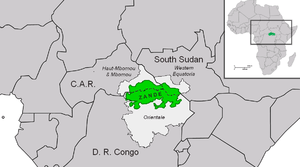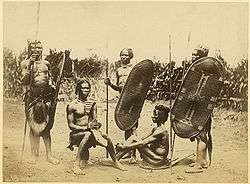Zande people
|
Azande men with shields, harp, between 1877 and 1880. | |
| Total population | |
|---|---|
| about 1.1 million | |
| Regions with significant populations | |
| Central African Republic, Democratic Republic of the Congo, South Sudan | |
| Languages | |
| Pa-Zande, Bangala, Sango and Arabic | |
| Religion | |
| Christianity, African Traditional Religion |
The Azande (plural of "Zande" in the Zande language) are an ethnic group of North Central Africa.
They live primarily in the northeastern part of the Democratic Republic of the Congo, in south-central and southwestern part of South Sudan, and in southeastern Central African Republic. The Congolese Azande live in Orientale Province, specifically along the Uele River; Isiro, Dungu, Kisangani and Dorima. The Central African Azande live in the districts of Rafaï, Bangasu and Obo. The Azande of South Sudan live in Central and Western Equatoria States, Yei, Maridi, Yambio and Tombura.
History
In the early 19th century, the Bandia people ruled over the Vungara and the two groups became the Azande people. They lived in the savannas of what is now the southeastern part of Central African Republic. After the death of a king, the king's sons would fight for succession. The losing son would often establish kingdoms in neighbouring regions, making the Azande kingdom spread eastward and northward. Sudanese raids halted some of northward expansion later in the 19th century. The Azande became divided by Belgium, France, and Anglo-Egyptian Sudan.[1]
Name and language

The word Azande means the people who possess much land, and refers to their history as conquering warriors. Variant spellings include Adio (Makaraka), Zande, Zandeh, A-Zandeh and Sandeh. The name Niam-Niam (or Nyam-Nyam) was frequently used by foreigners to refer to the Azande in the 18th and early 19th century. This name is probably of Dinka origin, and means great eaters in that language (as well as being an onomatopoeia), supposedly referring to cannibalistic propensities. This name for the Azande was in use by other tribes in South Sudan, and later adopted by westerners. Today the name Niam-Niam is considered pejorative.
Language
The Azande speak Zande, which they call Pa-Zande (also known as Pa-Dio, Zandi, Azande, Sande, Kizande, Bazande), which has an estimated 1.1 million speakers.[2] "Zande Language" is also used to refer to related languages in addition to Azande proper: including Adio, Barambu, Apambia (Bakpo), Geme, Kpatiri and Nzakara.
Demographics

The Azande population is spread over three Central African countries: South Sudan, the Democratic Republic of the Congo and the Central African Republic. Azande territory extends from the fringes of the South-central and Southwest Upper basin of South Sudan to the semitropical rain forests in Congo, and into the Central African Republic.
Estimates of Azande speakers reported in SIL Ethnologue (2009) are 730,000 in the Democratic Republic of the Congo, 62,000 in the Central African Republic (1996 estimate) and 350,000 in South Sudan (1982 estimate), amounting to a total population of just above 1 million.[2]
Agriculture
After World War II, the British government tried to encourage cotton cultivation in southern Sudan in a program known as the Zande Scheme. The program largely failed, partly because of the Azande's relative isolation to trading ports. Because of this isolation, many Azande have moved to towns closer to major roads.[1]
The Azande are mainly small-scale farmers. Crops include maize, rice, groundnuts (also known as peanuts), sesame, cassava and sweet potatoes. Fruits grown in the area include mangos, oranges, bananas, pineapples, and also sugar cane. Zandeland is also full of palm oil and sesame. From 1998 to 2001, Zande agriculture was boosted since World Vision International bought agricultural produce.—
Since then, the Azande have hunted and farmed millet, sorghum, and corn. Major cash crops include cassava and peanuts.[1]
Traditional beliefs

Most Azande traditionally practiced an African Traditional Religion, but this has been supplanted to a large extent by Christianity. Other traditional beliefs include magic and witchcraft. Among the Azande, witchcraft, or mangu, is believed to be an inherited substance in the belly which leads a fairly autonomous existence, and has power to perform bad magic on one's enemies. Since they believed that witchcraft is inherited, an autopsy of an accused witch would also prove that a particular living person, related to the deceased, was or was not a witch. Mangu is thought to be passed down from parent to child of the same sex—from father to son and from mother to daughter. Therefore if a man were to be proven to possess witchcraft substance, this conclusion would extend to that man's father, sons, brothers, and so on. However, the Azande rarely have a theoretical interest in witchcraft. What is important is whether a person at a particular point in time is acting as a witch toward a specific person.[3] Witches can sometimes be unaware of their powers, and can accidentally strike people to whom the witch wishes no evil. Because witchcraft is believed always to be present, there are several rituals connected to protection from and cancelling of witchcraft that are performed almost daily. When something out of the ordinary occurs, usually something unfortunate, to an individual, the Azande may blame witchcraft, just as non-Zande people might blame "bad luck".
Although witchcraft is contained within the physical body, its action is psychic. The psychic aspect of mangu is the soul of witchcraft. It usually, but not always, leaves the physical body of the witch at night, when the victim is asleep, and is directed by the witch into the body if the victim. As it moves, it shines with a bright light that can be seen by anyone during the nighttime. However, during the day it can be seen only by religious specialists.[3]
Oracles are a way of determining the source of the suspected witchcraft, and were for a long time the ultimate legal authority and the main determining factor in how one would respond to the threats.
There was also a social institution similar to pederasty in Ancient Greece. As E. E. Evans-Pritchard recorded, male Zande warriors between 20 and 30 years of age, in the northern Congo, routinely took on young male lovers between the ages of twelve and twenty, who participated in intercrural sex and sex with their older partners. The practice largely died out by the mid-19th century, after imperialist Europeans had gained colonial control of African countries, but was still surviving to sufficient degree that the practice was recounted in some detail to Evans-Pritchard by the elders with whom he spoke.[4]
In a 1951 study, two anthropologists determined that in Azande culture, long, pendulous breasts were seen as most attractive on women.[5]
Gallery
 Zande throwing knives
Zande throwing knives Zande woman in late 1870s with skin markings
Zande woman in late 1870s with skin markings Azande warriors
Azande warriors
See also
Notes
- 1 2 3 Appiah, Kwame Anthony; Gates Jr., Henry Louis, eds. (2005). Africana. 1 (2nd ed.). Oxford: Oxford University Press. p. 315. ISBN 9780195170559.
- 1 2 Zande in: Lewis, M. Paul (ed.), 2009. Ethnologue: Languages of the World, Sixteenth edition. Dallas, Tex.: SIL International.
- 1 2 'Stein1' 'Stein2', 'Rebecca L.1' 'Pilip L.2' (2016). The Anthropology of Religion, Magic, and Witchcraft. 2 Park Square, Milton Park , Abingdon, Oxon OX14 4RN 711 Third Avenue, New York, NY, 10017, USA: Routledge. p. 214. ISBN 9780205718115.
- ↑ E. E. Evans-Pritchard (December, 1970). "Sexual Inversion among the Azande". American Anthropologist, New Series, 72 (6), 1428-1434.
- ↑ "New Theory on Why Men Love Breasts".
References
-
 Chisholm, Hugh, ed. (1911). "Niam-Niam". Encyclopædia Britannica (11th ed.). Cambridge University Press.
Chisholm, Hugh, ed. (1911). "Niam-Niam". Encyclopædia Britannica (11th ed.). Cambridge University Press. - Evans-Pritchard, E. E. (1979) "Witchcraft Explains Unfortunate Events" in William A. Lessa and Evon Z. Vogt (eds.) Reader in Comparative Religion. An anthropological approach. Fourth Edition. New York: Harper Collins Publishers. pp. 362–366
- Evans-Pritchard, E. E. (1967) The Zande Trickster. Oxford: Clarendon Press.
- Evans-Pritchard, E. E.1937 Witchcraft, Oracles and Magic Among the Azande. Oxford University Press. 1976 abridged edition: ISBN 0-19-874029-8
| Wikimedia Commons has media related to Azande. |
